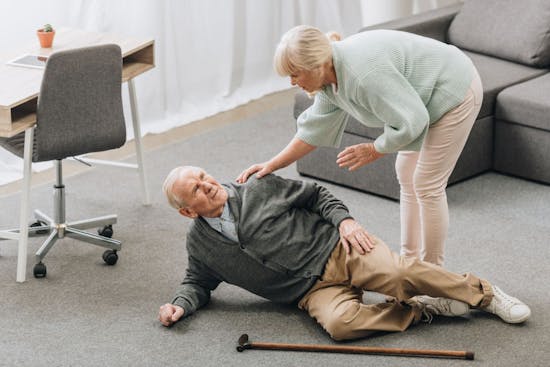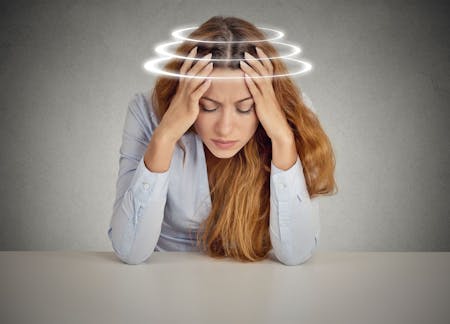A balance disorder is a condition that makes you feel unsteady or dizzy. If you are standing, sitting, or lying down, you might feel as if you are moving, spinning, or floating. If you are walking, you might suddenly feel as if you are tipping over.
Everyone has a dizzy spell now and then, but the term "dizziness" can mean different things to different people. For one person, dizziness might mean a fleeting feeling of faintness, while for another it could be an intense sensation of spinning (vertigo) that lasts a long time.
Experts believe that more than four out of 10 Americans, sometime in their lives, will experience an episode of dizziness significant enough to send them to a doctor. Balance disorders can be caused by certain health conditions, medications, or a problem in the inner ear or the brain. A balance disorder can profoundly impact daily activities and cause psychological and emotional hardship.

What are the symptoms of a balance disorder?
If you have a balance disorder, you may stagger when you try to walk or teeter or fall when you try to stand up. You might experience other symptoms such as:
- Dizziness or vertigo (a spinning sensation)
- Falling or feeling as if you are going to fall
- Lightheadedness, faintness, or a floating sensation
- Blurred vision
- Confusion or disorientation.
Other symptoms might include nausea and vomiting, changes in heart rate and blood pressure, and fear, anxiety, or panic.
Symptoms may come and go over short time periods or last for a long time and can lead to fatigue and depression.
What causes balance disorders?
There are many causes of balance problems, such as medications, ear infections, a head injury, or anything else that affects the inner ear or brain. Low blood pressure can lead to dizziness when you stand up too quickly. Problems that affect the skeletal or visual systems, such as arthritis or eye muscle imbalance, can also cause balance disorders. Your risk of having balance problems increases as you get older.
Unfortunately, many balance disorders start suddenly and with no obvious cause.
Common Diagnoses We Work With Include:
- Central Nervous System Disorders
- Neuropathy
- Age-Related Balance Dysfunction
- Oculomotor (Visual) Dysfunction
- Benign Paroxysmal Positional Vertigo (BPPV)
- Labyrinthitis
- Ménière's Disease
- Vestibular Neuronitis
- Muscle Atrophy
- Nerve Injuries

Dizziness
Vertigo (dizziness) is the sensation spinning or turning even when you're not. The word vertigo come from the Latin word "verter", which means "to turn", and the English word "whirling". This feeling may be anything from barely noticeable to severe enough to make it difficult to maintain your balance and do everyday tasks. The feeling may also be accompanied by:
- Nausea
- Dizziness and/or lightheadness
Doctors often categorize vertigo causes into two groups, according to whether the site of the problem is in the central nervous (brain) or the vestibular (peripheral) system. Thus, vertigo may be caused by certain parts of your brain (cerebral cortex, cerebellum, brainstem):
- Cerebrovascular Disease
- Migraine
- Multiple Sclerosis (MS)
- Acoustic Neuroma
Or vestibular system (vestibular labyrinth, semicircular canals or vestibular nerve):
- Benign paroxysmal positional vertigo (BPPV) - where certain head movements trigger vertigo
- An inner ear infection (labyrinthitis)
- Inflammation of the vestibular nerve (vestibular neuronitis)
Sometimes, it may even be caused by a fever, ringing in your ears (tinnitus) or even hearing loss.
Vertigo usually occurs when tiny particles, called otoconia, in the utricle (part of your inner ear) break loose and fall into the semicircular canals (other parts of your inner ear). The most common treatment for this problem is called the Epley Maneuver, a maneuver used to treat benign paroxysmal positional vertigo (BPPV) of the posterior or anterior canals.
It works by relocating the free-floating otolith crystals from the affected semicircular canal(s) back into the utricle, using gravity. This provides relief for many BPPV sufferers because the particles are no longer stimulating the cupula - the part of your vestibular system that provides the sense of spatial orientation. A few people may need subsequent treatments. Talk to your physical therapist if your symptoms don't improve.
Positional Vertigo - A Common Cause of Balance & Dizziness Disorders
If you have BPPV (benign paroxysmal positional vertigo), our vestibular therapy experts can perform a series of simple movements, such as the Epley maneuver, which can help dislodge the otoconia (calcium crystals) from the semicircular canal of the ear. In many cases, one session works; other people need the procedure several times to relieve their dizziness.
Treatment for Balance & Dizziness Disorders
There are more than a dozen causes of dizziness and many reasons why you might have difficulty with your balance.
Treatment of balance & dizziness disorders can be very complex. Nevertheless, we have helped numerous residents in the community cope with or recover from conditions that cause balance disorders.
The first thing your doctor will do if you have a balance problem is to determine if another health condition or a medication is to blame. If so, your doctor will treat the condition, suggest a different medication, or in many cases, refer you to one of our balance disorder experts here at Total Recovery Physical Therapy.
How Our Physical Therapists Can Help
Physical therapist directed treatment can assist patients with balance disorders in a number of ways. As experts in the evaluation and treatment of movement, muscle, joint, and nervous system disorders, our physical therapists can prescribe and implement a variety of treatments including:
- Coordination Exercises
- Proprioception Exercises
- Strengthening Exercises
- Stretching and Range of Motion Exercises
- Posture Exercises
- Retraining of the Inner Ear
- Visual Tracking Training
Education is Therapy
The most important part of treating a balance disorder is understanding your diagnosis, the cause of the problem, and how to manage it. That's why we place great emphasis on patient education and coordination of care with your referring physician.
Three Additional and Important Treatment Options
Reduce Fall Risk. Your physical therapist will assess problem footwear and hazards in your home that increase your risk of balance problems or falling. Household hazards include loose rugs, poor lighting, unrestrained pets, or other possible obstacles.
Reduce Fear of Falling. By addressing specific problems that are found during the examination, your physical therapist will help you regain confidence in your balance and your ability to move freely and perform daily activities. As you build confidence in your balance and physical ability, you will be better able to enjoy your normal daily activities.
Care Collaboration. Working in collaboration with your medical doctor, allows you to get two expert opinions and assessments of your condition. Together, we can better address your balance disorders and decrease your fear of falling and fall risks.
When should I seek help if I think I have a balance disorder?
To help you decide whether to seek medical help for a dizzy spell, ask yourself the following questions. If you answer "yes" to any of these questions, talk to one of our physical therapists and your doctor:
- Do I feel unsteady?
- Do I feel as if the room is spinning around me?
- Do I feel as if I'm moving when I know I'm sitting or standing still?
- Do I lose my balance and fall?
- Do I feel as if I'm falling?
- Do I feel lightheaded or as if I might faint?
- Do I have blurred vision?
- Do I ever feel disoriented–losing my sense of time or location?
We Can Help You Cope With Your Condition
The physical therapists at Total Recovery Physical Therapy can also help increase your strength and coordination to help lower your risk of falling and getting hurt during daily activities, such as when you walk up or downstairs, use the bathroom, or exercise.
Some people with a balance disorder will need the help of our vestibular rehabilitation therapists to cope with their problems. In each case, we will conduct a personalized evaluation of your condition and then we will develop an individualized treatment plan.
Call Today
Call us today to learn more about how we can develop a personalized treatment program for your balance problems and help you get back to enjoying a higher quality of life.
Reference: ChoosePT Guide: Physical Therapist's Guide to Balance Problems
